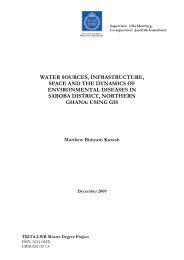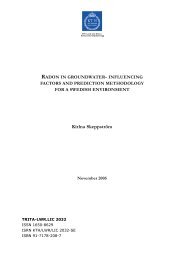Comparison between 1D and 2D models to analyze the dam break
Comparison between 1D and 2D models to analyze the dam break
Comparison between 1D and 2D models to analyze the dam break
- No tags were found...
You also want an ePaper? Increase the reach of your titles
YUMPU automatically turns print PDFs into web optimized ePapers that Google loves.
<strong>Comparison</strong> <strong>between</strong> <strong>1D</strong> <strong>and</strong> <strong>2D</strong> <strong>models</strong> <strong>to</strong> <strong>analyze</strong> <strong>the</strong> <strong>dam</strong> <strong>break</strong> wave• Determining a <strong>dam</strong> breach formation (flowhydrograph).• Determining roughness coefficients used inflow simulations.• The effect of debris flow <strong>and</strong> urban areas in a<strong>dam</strong>-<strong>break</strong> hazard analysis.8.- CON CL USION.One of <strong>the</strong> main goals of this study was <strong>to</strong> show <strong>the</strong>capacity of a general <strong>to</strong>ol called Comsol Multiphysics<strong>to</strong> deal with <strong>dam</strong>-<strong>break</strong> simulations. This capacity hasbeen proved even though it has been done using asimple <strong>and</strong> idealized case. In parallel with <strong>the</strong> rapiddevelopment of computer technology within <strong>the</strong> last20 years, <strong>dam</strong> <strong>break</strong> <strong>and</strong> flood simulations havestepped from <strong>the</strong> use of simplified <strong>models</strong> <strong>to</strong> onedimensionalchannel network <strong>models</strong> <strong>and</strong> finally <strong>to</strong>expensive two-dimensional <strong>models</strong>. The trend is <strong>to</strong>minimize <strong>the</strong> expert work in favor of computerresources.The main improvement expected from a <strong>2D</strong>computation was in terms of <strong>the</strong> accuracy of <strong>the</strong>predicted propagation times. After <strong>the</strong> comparisondone in this work we don’t see this improvementbecause <strong>the</strong> <strong>models</strong> used have been <strong>the</strong>oretical <strong>and</strong>without irregularities, it has not been a realisticapproach. The use of a <strong>1D</strong> model needs a lot ofexperience since <strong>the</strong> cross-sections have <strong>to</strong> be put at<strong>the</strong> right locations. The use of a <strong>2D</strong> model is morestraightforward. However, <strong>the</strong> results of <strong>the</strong> <strong>1D</strong>approach are actually considered good because <strong>the</strong>yare on <strong>the</strong> safe side <strong>and</strong> safety is <strong>the</strong> key concept in<strong>the</strong>se problems.The <strong>1D</strong> approach is even recommended by somedepartments like <strong>the</strong> Spanish Ministry ofEnvironment, where in its “Technical guide for <strong>the</strong>development of emergency action plans for <strong>dam</strong>s” we read: “Ingeneral, it is desirable <strong>to</strong> use <strong>1D</strong> <strong>models</strong> because <strong>the</strong>y aresufficiently accurate <strong>and</strong> <strong>the</strong> <strong>2D</strong> <strong>models</strong> usually are complex <strong>to</strong>model <strong>and</strong> <strong>to</strong> get <strong>the</strong> basic data (<strong>to</strong>pography, directionalroughness, etc.) <strong>and</strong> force us <strong>to</strong> assume additional simplifications<strong>to</strong> take in<strong>to</strong> account <strong>the</strong> second dimension.”Thinking in terms of implementation, it is clear that<strong>the</strong> <strong>1D</strong> approach is valid because it is conservative <strong>and</strong>good enough; however, actually it is possible <strong>to</strong> thinkabout more <strong>and</strong> more accurate <strong>2D</strong> <strong>models</strong>, thanks <strong>to</strong><strong>the</strong> rapid development of <strong>the</strong> technology. Today’sstate of <strong>the</strong> art procedure is <strong>to</strong> develop complexterrain <strong>models</strong> <strong>and</strong> superimpose <strong>the</strong>m with floodcomputation parameters.Although a general conclusion of this report could bethat it is necessary <strong>to</strong> decide <strong>between</strong> <strong>1D</strong> <strong>and</strong> <strong>2D</strong>, it isnot quite that simple. The use of one doesn’t exclude<strong>the</strong> o<strong>the</strong>r. In fact, it is desirable <strong>to</strong> take both of <strong>the</strong>min<strong>to</strong> consideration. The resources for <strong>the</strong> <strong>1D</strong> approach(computers <strong>and</strong> software) are more accessible,<strong>the</strong>refore this approach is very useful <strong>to</strong> getconservative screenings at <strong>the</strong> beginning. If <strong>the</strong>resources <strong>and</strong> data are available, a <strong>2D</strong> model isadvisable for all <strong>the</strong> reasons expounded previously. Inaddition, <strong>the</strong> results of <strong>the</strong> performed <strong>1D</strong> model canbe a great help <strong>to</strong> predict <strong>the</strong> results in <strong>the</strong> <strong>2D</strong> model.In practice, <strong>the</strong> implementation may be best achievedcombining <strong>1D</strong> <strong>and</strong> <strong>2D</strong> <strong>models</strong>. A framework for a<strong>dam</strong> <strong>break</strong> analysis is summarized in <strong>the</strong> Appendix,where <strong>the</strong> current practice is presented according <strong>to</strong><strong>the</strong> ICOLD (International Commission On LargeDams) recommendations. As it can be seen in <strong>the</strong>Appendix, <strong>the</strong> analysis is based using <strong>1D</strong> <strong>and</strong> <strong>2D</strong><strong>models</strong>.Typically <strong>1D</strong> <strong>models</strong> are based on finite differencemethods (FDM). Apart from <strong>the</strong> research, even <strong>the</strong>largest energy companies achieve <strong>the</strong> <strong>dam</strong> <strong>break</strong> floodanalysis with this kind of one-dimensional approach. Itis faster, cheaper <strong>and</strong> <strong>the</strong> results are fully satisfac<strong>to</strong>ry.The <strong>dam</strong> <strong>break</strong> studies have been attempted with <strong>the</strong><strong>1D</strong> approach in <strong>the</strong> past, actually <strong>the</strong> “<strong>1D</strong>+<strong>2D</strong>”approach is becoming more common, <strong>and</strong> in <strong>the</strong>future, when <strong>the</strong> resources are completely accessible,<strong>the</strong> <strong>2D</strong> approach could be <strong>the</strong> primary way <strong>to</strong> achieve<strong>the</strong>se analyses.23
















